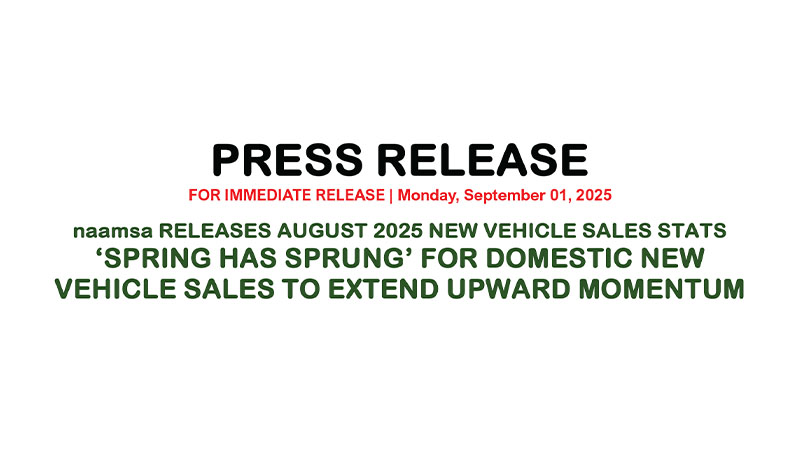PRETORIA: Monday, September 01, 2025 | August’s new vehicle sales performance reaffirms that domestic demand continues to do the heavy lifting for South Africa’s automotive sector even as export channels confront heightened policy headwinds. New vehicle sales in August maintained upward momentum domestically to its highest level since October 2019, while export volumes also gained traction despite the fact that manufacturers and suppliers continued to adjust to renewed US tariff uncertainty and increasing global competition.
Aggregate new vehicle sales increased to 51,880 units in August 2025, up 8,188 units, or 18,7%, from the 43,692 units sold in August 2024. This strength has been driven by an ongoing influx of affordable models, improving consumer confidence, favourable credit conditions, and a steady recovery in disposable incomes.
Overall, out of the total reported industry sales of 51,880 vehicles, an estimated 43,196 units, or 83,3%, represented dealer sales, an estimated 12,1% represented sales to the vehicle rental industry, 2,3% to industry corporate fleets, and 2,3% to government sales.
The August 2025 new passenger car market at 36,914 units, its highest level since September 2015, registered an increase of 6,786 cars, or a gain of 22,5%, compared to the 30,128 new cars sold in August 2024. Car rental sales accounted for a sound 15,0% of new passenger vehicle sales during the month. Domestic sales of new light commercial vehicles, bakkies and mini-buses at 12,326 units during August 2025 had recorded an increase of 1,616 units, or a gain of 15,1%, from the 10,710 light commercial vehicles sold during August 2024.
Sales for medium and heavy truck segments of the industry reflected a weak performance in August 2025 and at 717 units and 1,923 units, respectively, recorded a decrease of 29 units, or 3,9% from the 746 units sold in August 2024 in the case of medium commercial vehicles, and, in the case of heavy trucks and buses a decrease of 185 vehicles, or 8,8%, compared to the 2,108 units sold in the corresponding month last year.
Core domestic demand remained a key driver of new vehicle sales growth in August. The South African Reserve Bank’s [SARB] decision at the end of July to reduce the repo rate by 25 basis points to 7.00% further reinforced this momentum. The shift in market conditions lowered financing costs for households and dealer floorplans, broadening access to credit for vehicle purchases. Importantly, Treasury’s clarification that any move toward a lower inflation target would only follow full consultation helped anchor confidence and limit policy uncertainty.
Credit conditions also continued to improve. Household credit extension rose by 3.1% y/y in June, while private-sector credit growth firmed to 5.0% y/y, reflecting a gradual loosening in borrowing conditions that supported big-ticket spending, including motor vehicles. Together with modest gains in real disposable incomes, these trends provided a stable foundation for sustained demand in the new vehicle market through August.
Inflation dynamics in July remained broadly contained but edged higher. Headline CPI rose to 3.5% y/y [0.9% m/m] from 3.0% y/y [0.3% m/m] in June, largely reflecting food and fuel price dynamics, while core inflation ticked up slightly to 3.0% y/y. In early August, fuel price adjustments delivered a mixed outcome: consumers benefited from a 28c/litre cut in petrol prices, while diesel costs rose by 63 – 65c/litre, adding pressure to logistics-intensive sectors. Brent crude prices, trading close to US$68 – 69/bbl, remained within a manageable range. This balance provided relief and confidence for retail buyers, even as it posed a modest headwind for transport operators and commercial fleets.
Vehicle export volumes for the month of August 2025 increased by 2,190 units, or 6,2% from the 35,310 units exported in August 2024 to 37,500 units exported in August 2025. For the year to date, vehicle exports were still 3,0% ahead of the same period 2024 but are anticipated to come under increased pressure in the near term as the sector continues to adjust to higher tariff barriers to the US market as well as to adjust to the knock-on implications of the tariffs resulting in increasing global competition in other traditional export markets. The industry’s ongoing focus will remain to navigate potential re-routing and further market diversification strategies.
With a month to go, attention now turns to the upcoming SA Auto Week 2025, to be held from 01 – 03 October in Gqeberha, Eastern Cape Province. Under the theme “Reimagining the Future, TOGETHER: Cultivating Inclusive Growth and Shared Prosperity,” the gathering will serve as a platform for forging bold industrial alliances, recommitting to trade diplomacy, and accelerating South Africa’s just energy transition within the automotive ecosystem. The Eastern Cape is not only the birthplace of naamsa 90 years ago; it remains the province at the heart of South Africa’s automotive industrial capacity. Accordingly, new vehicle sales for the month of October will be released on 02 October 2025 during SA Auto Week 2025.
View the Flash Report Here.










